Click on images to enlarge
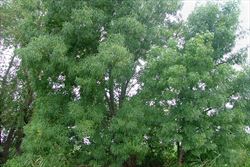
infestation on the bank of a waterway (Photo: Sheldon Navie)
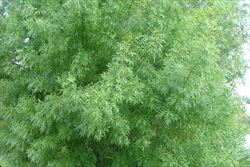
habit in spring (Photo: Sheldon Navie)

habit in winter (Photo: Sheldon Navie)

old trunk (Photo: Sheldon Navie)
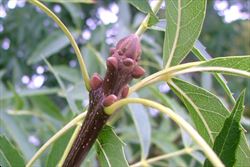
close-up of dark brown growing buds, leaf stalks, and young branch with small white spots (Photo: Sheldon Navie)

once-compound leaves (Photo: Sheldon Navie)
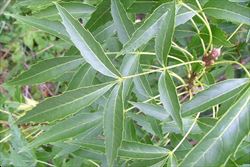
leaf with several elongated leaflets (Photo: Sheldon Navie)
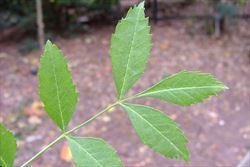
close-up of leaflets showing toothed margins (Photo: Sheldon Navie)

clusters of immature fruit (Photo: Sheldon Navie)

close-up of immature fruit (Photo: Sheldon Navie)
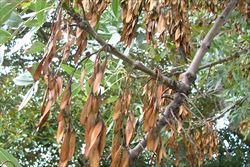
clusters of mature fruit (Photo: Sheldon Navie)
Scientific Name
Fraxinus angustifolia Vahl subsp. angustifolia
Synonyms
Fraxinus angustifolia VahlFraxinus oxycarpa Willd.Fraxinus rotundifolia Mill. subsp. rotundifolia
Family
Oleaceae
Common Names
ash, desert ash, narrow leaf ash, narrow leaved ash, narrowleaf ash, narrow-leaved ash
Origin
Native to north-western Africa (i.e. northern Algeria, Morocco and Tunisia) and south-western Europe (i.e. France, Portugal and Spain).
Cultivation
Desert ash (Fraxinus angustifolia subsp. angustifolia) was a very popular garden and street tree and was widely cultivated in the temperate regions of Australia. The typical form of this plant is not commonly planted any more, however large numbers of adult trees can still be seen growing in suburban areas. The cultivar known as claret ash (Fraxinus angustifolia 'Raywood'), which can be distinguished by its reddish coloured autumn leaves, is still popular in cultivation. It does not produce fruit and has been recommended as a replacement for desert ash (Fraxinus angustifolia subsp. angustifolia).
Naturalised Distribution
Naturalised in many parts of south-eastern Australia (i.e. in south-eastern and eastern South Australia, Victoria, the ACT and parts of southern and eastern New South Wales). It is also sparingly naturalised in south-eastern Queensland and possibly naturalised in south-western Western Australia.
Naturalised overseas in southern Africa.
Habitat
A weed of roadsides, disturbed sites, waste areas, waterways, riparian areas, wetlands, grasslands and open woodlands in the temperate regions of Australia.
Habit
A large spreading tree usually growing up to 10-12 m tall, but occasionally reaching up to 20 m in height. This species loses its leaves during autumn (i.e. it is deciduous).
Distinguishing Features
-
a large spreading tree, usually growing up to 10-12 m tall, that loses its leaves in autumn.
-
its growing buds are dark brown in colour.
-
its compound leaves (14-25 cm long) have 5-13 elongated leaflets with toothed margins.
-
its inconspicuous flowers are borne in small branched clusters and do not have any sepals or petals.
-
its winged fruit (3-5 cm long) are narrowly oval in shape and often slightly twisted.
Stems and Leaves
The older stems are greyish in colour and the bark on the main trunk can become quite rough and fissured with age. Younger stems are greenish-brown or yellowish, hairless (i.e. glabrous), and with small whitish spots (i.e. lenticels). The growing buds at the tips of the branches are dark brown and hairless (i.e. glabrous).
The compound (i.e. pinnate) bright green leaves are oppositely arranged or borne in threes (i.e. whorled) along the branches. They usually have about seven leaflets, but can have as many as thirteen or as few as five leaflets. These leaves (14-25 cm long) are borne on long stalks (i.e. petioles) and turn yellowish before falling in autumn. The leaflets (3-8 cm long and 0.7-2 cm wide) are usually somewhat elongated in shape (i.e. narrowly ovate to elliptic) with toothed (i.e. serrate) margins. They are also hairless (i.e. glabrous) with gradually tapering (i.e. cuneate) bases and pointed tips (i.e. acuminate apices).
Flowers and Fruit
The inconspicuous flowers appear in late winter or early spring when the tree is still leafless. They are borne in dense branched clusters above the old leaf scars (i.e. in axillary panicles). These clusters can contain only male flowers, only bisexual flowers, or a mixture of male and bisexual flowers. However, all trees have at least some male and some bisexual flowers. Both types of flowers lack sepals or petals. The male flowers consist of two stamens, while the bisexual flowers have two stamens and an ovary topped with a short style and two-lobed stigma.
The winged fruit, known as a samara, usually contains a single seed. This fruit (3-5 cm long) is narrowly oval (i.e. elliptic) in shape and often slightly twisted. The seed portion of the fruit is about 1.5-2 cm long and so is the flattened wing portion. Immature fruit are greenish in colour, sometimes tinged with pink or red, but turn pale brown as they mature.
Reproduction and Dispersal
This species reproduces by seed and will also spread laterally via root suckers. Pieces of stem and branches can also take root when they come into contact with moist soil (i.e. a process known as layering).
The winged seeds are mainly dispersed by wind and in dumped garden waste. However, they are also thought to be spread by animals (e.g. birds, foxes and posums). Pieces of stem can be dispersed during floods and in dumped garden waste.
Environmental Impact
Desert ash (Fraxinus angustifolia subsp. angustifolia) is regarded as an environmental weed in Victoria, South Australia, the ACT and southern New South Wales. It has spread from deliberate plantings into creeks and river systems, wetlands, urban bushland, lowland grasslands and grassy woodlands. This species out-competes native plants for moisture, light and nutrients and can take over the vegetation in natural areas. Over time it forms dense monocultures, spreading via suckers and preventing the regeneration of native species. It is of particular concern in disturbed riparian areas and along drainage lines, and the largest infestations are currently located near Melbourne and Adelaide.
Desert ash (Fraxinus angustifolia subsp. angustifolia) is a common environmental weed in the greater Adelaide region and is actively managed by community groups in South Australia. For example, in the City of Mitcham, in Adelaide, this species is regarded as an invasive plant of the highest severity rating. Desert ash (Fraxinus angustifolia subsp. angustifolia) also appears on numerous local and regional environmental weed lists in Victoria (e.g. in Monash City, Mitchell Shire, Knox Shire, the Shire of Yarra Ranges, Mornington Peninsula and the Goulburn Broken Catchment). It is also listed as a common invasive tree species in the North Central Region of this state and is regarded as a threat to some native plant communities (e.g. it is a high impact weed in floodplain riparian woodlands). Desert ash (Fraxinus angustifolia subsp. angustifolia) is also an emerging environmental weed in the southern highlands of New South Wales and in the ACT.
Legislation
Not declared or considered noxious by any state government authorities.
Management
For information on the management of this species see the following resources:
- the Shire of Yarra Ranges fact sheet on this species, which is available online at http://www.yarraranges.vic.gov.au.
- Muyt (2001), Bush Invaders of South-east Australia, pp. 237-238.
Similar Species
Desert ash (Fraxinus angustifolia subsp. angustifolia) is extremely similar to European ash (Fraxinus excelsior) and also relatively similar to flowering ash (Fraxinus ornus) and Himalayan ash (Fraxinus grifithii). These species are all cultivated and occasionally naturalised in Australia. They can be distinguished by the following differences:
- desert ash (Fraxinus angustifolia subsp. angustifolia) leaves have elongated leaflets with toothed (i.e. serrate) margins. It loses its leaves during winter (i.e. is deciduous) and its leaf buds are dark brown in colour. Separate male and bisexual flowers are borne on the same tree, and these small flowers are inconspicuous and without any petals. Its winged fruit are relatively large (3-5 cm long).
- European ash (Fraxinus excelsior) leaves have relatively broad or elongated leaflets with toothed (i.e. serrate) margins. It loses its leaves during winter (i.e. is deciduous) and its leaf buds are blackish in colour. Separate male and female flowers are borne on the same tree or on separate plants, and these small flowers are inconspicuous and without any petals. Its winged fruit are relatively large (3-5 cm long).
- flowering ash (Fraxinus ornus) leaves have relatively broad or elongated leaflets with finely toothed (i.e. serrate) margins. It loses its leaves during winter (i.e. is deciduous) and its leaf buds are grey or greyish-brown in colour. Male and female flowers are borne on separate plants, and these small flowers are quite showy with four white petals. Its winged fruit are relatively large (2.5-5 cm long).
- Himalayan ash (Fraxinus grifithii) leaves have relatively broad or elongated leaflets with entire margins. It does not lose its leaves during winter (i.e. it is evergreen) and its leaf buds are usually green or greenish-brown in colour. The small bisexual flowers are quite showy with four white petals. Its winged fruit are relatively small (2.5-3 cm long and 4-5 mm wide).

